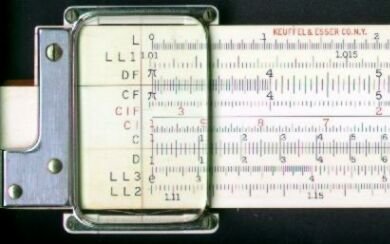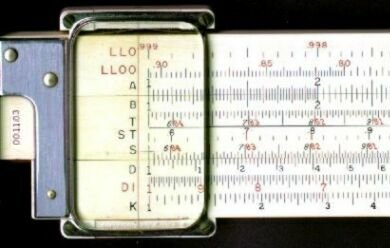Slide Rules
Obi-Wan Kenobi somewhere refers to the light saber as "an elegant weapon from a more civilized time." Yeah, that's sort of how I feel about slide rules...

(Click on this and all pictures for a complete full-size view of the slide rule)
Understand, I was originally going to be a mathematician. In fact I spent three years as a teaching assistant in the math department at the University of Wisconsin-Madison. In those days I had a string of calculators, which were then a fairly new item. True, in high school we'd learned to use slide rules. But calculators had rendered slide rules obsolete... hadn't they?
It was only many years later that I began running across old slide rules at garage sales, at St. Vincent's, in antique malls. I still had an old circular Pickett from my high school days. I've accumulated a small but nice collection of about two dozen different slide rules.
My favorite is the Keuffel & Esser Log Log Duplex Decitrig, model

I have this very slide rule sitting in its leather case on my desk, and I often use it in preference to a calculator. Hey, you can figure things on it just as fast as on a scientific calculator, and it doesn't need batteries.
It provides answers to only three significant figures, but in the real world, that's all the precision you need anyhow. Multiplication, division, reciprocals, square roots, cube roots, logarithms, sines, tangents, any powers or roots you want... a "slipstick" like my K&E Log Log Duplex Decitrig can work problems involving all these and more.
In fact, I must confess I'm something of a Selective Luddite™, and of that my slide rules are one sign. I know in the blogosphere it's fashionable to say, "I'm no Luddite!", as if to reassure everyone, with a slightly strained air: "Me okay! Me okay!"
Well, I don't particularly care whether I'm "okay" or not. Often "okay" simply means you've learned "good citizensheep." As for science and technology, I love them— only I aim, insofar as I can, to control their role in my life. Not to let them control me. And in particular not to let our cultural interpretations of science and technology control me.
I repeat, I love technology. But only if, in my judgment, that technology enriches my life. Only if, in my judgment, that technology adds to my convenience, or to my being in greater control of my life.
Technology which impoverishes my life— which makes my life more of a hassle— which ends up controlling me instead of me controlling it— technology like that, I'll do without, if I can at all get away with it.
And that's why I've got on my desk both a computer and a slide rule. And why I've so far avoided getting a cell phone; in fact, I only just barely tolerate telephones at all. (Idea for a science fiction story: somebody travels back in time, and strangles Alexander Graham Bell in his cradle.)

But a slide rule is both physically and conceptually a thing of beauty. Physically, that solid mahogany, those finely machined scales... my slide rule, like I say, dates back to about 1940, and I suspect that to someone of that era, the stainless steel endpieces would stand out, too. I mean, that whole beautiful slide rule of mine is just so New York World's Fair...
Physically. And conceptually... conceptually you find yourself in close quarters with numbers and with mathematical functions when you're using a slide rule. You can do math by punching buttons on a calculator, without really understanding what you're doing. But to do math with a slide rule is to gain a deep acquaintance with math and with numbers.
A deep acquaintance with math and with numbers; and, if you will, with depths deeper than mere mathesis.
Observe, for instance, how numbers seem to us to be important, significant, "thick," with a weighting roughly proportional to their distribution on the LL3 scale of a slide rule. Each of the lower integers has its own very distinct "personality"— note how 2 appears lower down, on a scale of its own, and how 1 does not appear on any
If numbers have weight, feel, the sort of heft which a good tool has when held in the hand— then this is roughly the distribution of their weighting. It looks very much like a logarithmic distribution, very much like the LL3 scale on a slide rule.
This is an insight which surely the ancient Pythagoreans would have appreciated. And, philosophical realist that I am, I cannot but feel that here is symbolized some deep objective truth about the numbers themselves— about Reality with a

Still, you don't have to settle for "good citizensheep" and being "okay." Nor for Luddism plain and simple. No, you can stand on your own two feet, and be a Selective Luddite™. Don't let technology, or worse yet our facile cultural interpretations of science and technology, deaden your soul. Use and enjoy the fruits of science and technology, rejoice in them; only you use them, don't let them use you. Let them enhance and deepen your soul, not deaden it.
</hippie-dippie quasi-sixties rant> :-)
Someone has observed that one of the cool things about the slide rule is that the ancient Romans could have had slide rules, if only they'd had the concept of logarithms. This is true, though with Roman numerals a slide rule would still have been a difficult thing to conceptualize.
Easier to imagine is the idea of the ancient Mayans having had slide rules, with their positional number notation in base twenty, and the notion of zero. If only the Mayans had had logarithms... I can just imagine a Mayan slide rule, inlaid with jade, vigesimal, incised with curious Mayan hieroglyphics...
Labels: best_of, doors_of_perception, slide_rules








2 Comments:
Well said! I saw your post and thought you might find this interesting: http://sliderulemuseum.com/KE_Standard.htm It's sort of a memorial to past scientists and engineers and pictures of the slide rules they used, some to accomplish very pivotal projects, some more obscure, and some used in college and then forgotten in a drawer until donated.
Found a K&E 4081-3 with the added D1 scale from 1953, in mint condition, at the local thrift shop for a buck. What a find. Working with a slide builds intuition about numbers, since you need to have some vague idea what the answer will be to get the order of magnitude right. 17 * 53 is going to be around 800, for example. Or the square root of 71, which will be twixt 8 and 9.
It's just plain *fun* to work problems with a slide rule, since you're doing something physical instead of just punching buttons on a calculator. Calculators provide no intuition no matter how often you use 'em.
Guesstimating the third significant digit also requires you to use your head. You take the least significant digits of the two numbers you're dealing with and ask yourself "What is the answer likely to be?" For division, this exercises your mind with simple divisibility rules, like checking to see if a number is divisible by 4 by seeing if the two digits at the end are divisible by 4 &c.
Post a Comment
<< Home